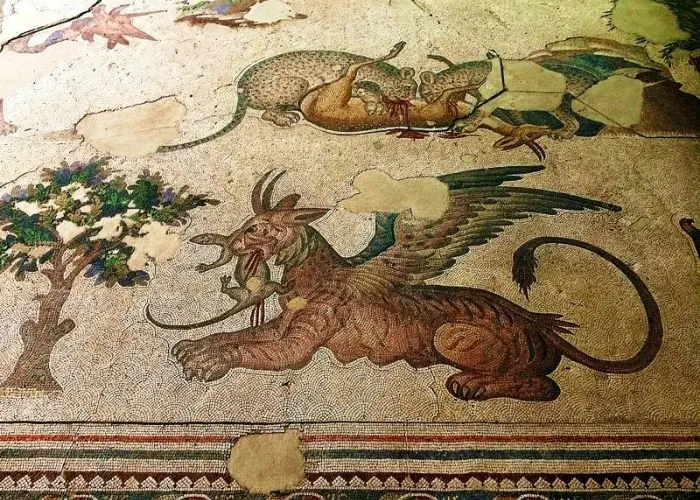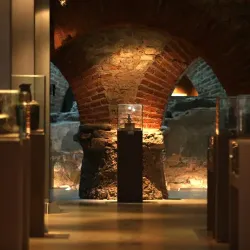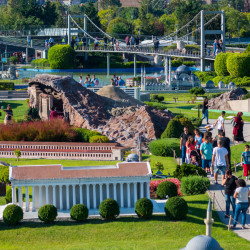One of the most distinctive art forms with a close relationship to Anatolian history is mosaic art. If you ever want to see some of its best specimens, visit the Great Palace Mosaic Museum in Istanbul, which houses over 250 m2 of these vast antique images made of tens of thousands of small colorful pieces.
The museum was established to preserve the Eastern Roman Period mosaic floor treatment that partially survived in the Northeastern corner of the colonnaded courtyard of the Great Palace. It is housed inside the Arasta Market in the Blue Mosque Complex.
These mosaics, which date back to the early Byzantine era, are priceless historical treasures that transport us hundreds of years in the past. Here is every piece of information you might need to know prior to your visit if you are interested in taking a tour of the Great Palace Mosaic Museum.
Inside the Great Palace Mosaic Museum
The mosaics, which were discovered in 1935 during excavations in the northeastern cloister of the Eastern Roman Grand Palace, are extraordinary both in terms of their aesthetic quality and the depth of the themes they depict. There is no religious element in the mosaics on display in the Great Palace Mosaics Museum, which date from 450 to 550 AD. The numerous professionals working under the direction of the top masters of the time are undoubtedly responsible for the vibrancy of the representations drawn from everyday life, nature, and mythology.
More than 250 m2 of vibrant mosaic art with 150 unique characters, 90 scenes, items, and legendary creatures can be seen in the Mosaic Museum Istanbul. The intricate workmanship in these mosaics suggests that many of the most talented artisans from across the Roman Empire were involved.
Numerous pictures, as well as some mythological beings, depict Romans going about their daily lives. Numerous scenes are there, such as an arena, hunters, various animals, people carrying pots, predatory animals pursuing prey, mythical foes like the Bellerophon and the Chimera fighting, shepherds, and so forth.
Two hunters may be seen aiming spears at tigers in one of the hunting pictures. They have bandages on their legs for protection, and they are dressed in sleeveless shirts, tunics, and scarves. These display the attire worn by Roman hunters in the sixth century. They also have what appears to crest from guard regiments on their clothing, which could indicate that they were employees of the palace.
Another beautiful mosaic depicts the battle between Bellerophon, a legendary Greek warrior, and the fabled three-headed beast Chimera. Bellerophon is thrusting his spear at Chimera's goat head while Chimera's lion head is sticking out its trident tongue, and most of Bellerophon's picture has rotted. The serpent tail of the Chimera is also visible.
Another mosaic depicts Dionysus, the ancient Greek deity of wine, revelry, and theater, as a youngster. During what appears to be his victory parade in India, he is seated atop Pan's shoulders and sporting a leaf-based crown. The African elephant and its rider can be seen trailing Pan while he is carrying a flute.

The Mosaic Technique
There are three main levels to the mosaics on display in the Great Palace Mosaic Museum:
-
Approximately 0.30 to 0.50 meters of the statue are present at the bottom, followed by a mortar layer that is 9 centimeters thick.
-
Compressed slime, earth, and charcoal were employed for the second layer. Broken tiles were arranged in a thicker layer on top of this one.
-
They next piled the mortar for the mosaic's foundation on top of these two layers.
Thousands of 5 mm-sized colored cubes of limestone and marble, red, blue, green, and black glass shades, pieces of rust-colored clay, terracotta, and some valuable stones were utilized to produce the actual images that can be seen on the mosaic pieces. These mosaics have around 40,000 cubes per m2, which indicates that 75–80 million cubes were used in the complete mosaic.
How to Get to the Great Palace Mosaic Museum
The Great Palace Mosaic Museum is located in the Sultanahmet area of the Fatih district, the same as the majority of historical museums and monuments in Istanbul. The best way to reach there is to take the Kabatas - Bagcilar tramway line and get out at the Sultanahmet stop. To get to the Kabatas - Bagcilar tramway line from Taksim, take the Taksim - Kabatas funicular line.
You can take the Eminonu ferries from Kadkoy or Uskudar to the Asian side, where you can connect to the Kabatas - Bagcilar tramway line.
Arriving at the Sultanahmet stop, proceed to the area surrounding the Blue Mosque and seek out the Arasta Bazaar. You can quickly locate the Great Palace Mosaic Museum from there.
Visiting the Great Palace Mosaic Museum
The operating hours of the Mosaic Museum Istanbul are 9 AM to 7 PM during the summer season, which runs from 1 April to 31 October, and 9 AM to 5 PM during the winter season, which runs from 1 November to 31 March.
The entrance cost to the Istanbul Mosaic Museum is around 120 TL per adult, and the ticket booths close around an hour before the museum's closing time. If you intend to visit further museums, including Hagia Sophia, Topkapi Palace, and the Museum of Turkish and Islamic Arts, you should think about purchasing an Istanbul Tourist Pass because it will save you both time and money.
Great Palace Mosaics Museum is temporarily closed.
Frequently Asked Question
What are the working hours of the Mosaic Museum?
The museum is Open:
May-Sept. Tuesday through Sunday, 9 am to 7 pm.
Oct.-April Tuesday through Sunday, 9 am to 5 pm.
Great Palace Mosaic Museum is closed on Mondays.
How much time is required to visit?
It is a small museum so you may spend a maximum of 1 hour in the museum.
Where is this museum located?
Take the stairs down to Arasta Bazaar from the open space between the Blue Mosque and the Hagia Sophia.
 Hungarian
Hungarian  Indonesian
Indonesian  Urdu
Urdu  Taiwanese
Taiwanese  Russian
Russian  Romanian
Romanian  Portuguese
Portuguese  Persian
Persian  Macedonian
Macedonian  Korean
Korean  Japanese
Japanese  Italian
Italian  Indian
Indian  Greek
Greek  German
German  Croatian
Croatian  Chinese
Chinese  Bulgarian
Bulgarian  Arabic
Arabic  French
French  Spanish
Spanish  English
English 




